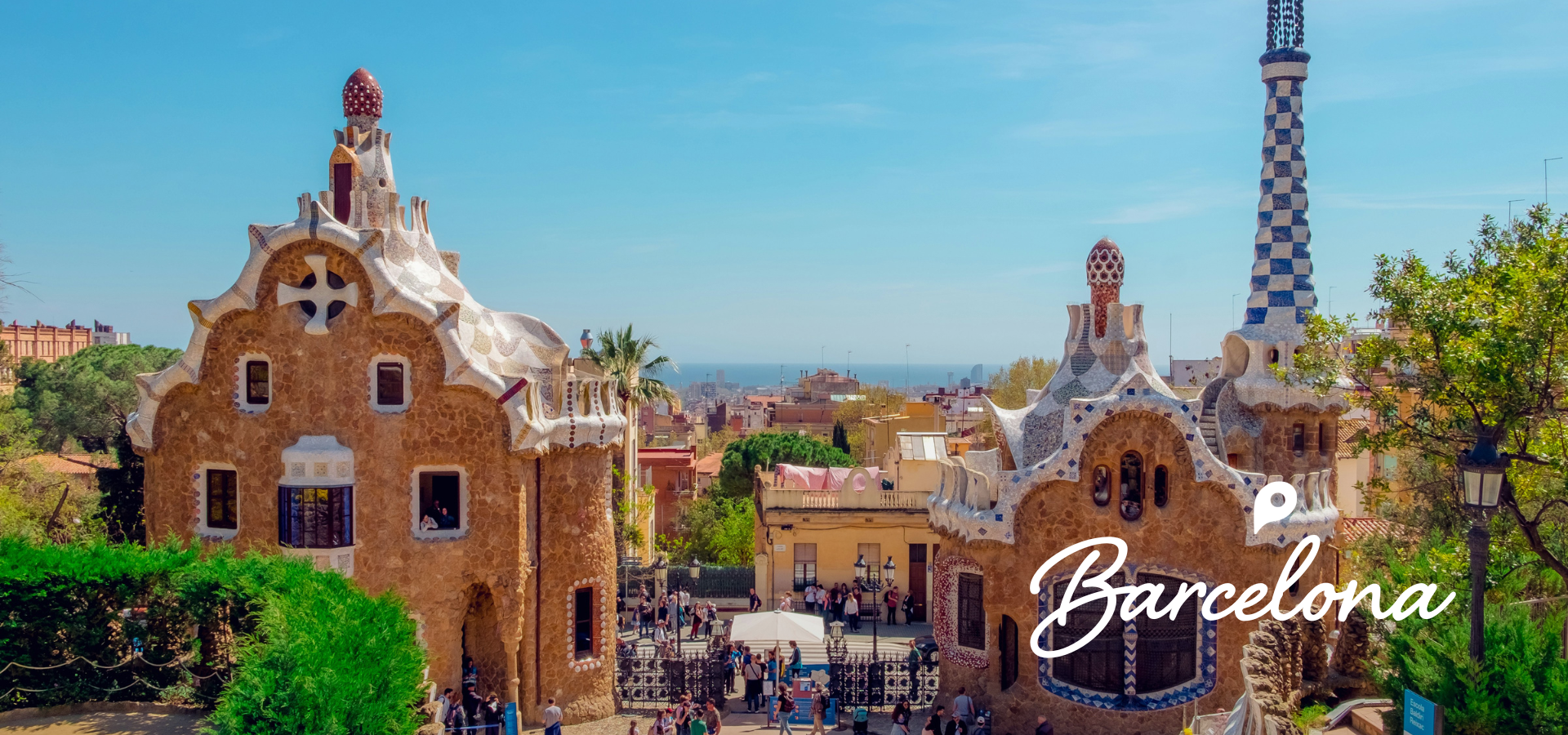With the Sagrada Familia’s 2026 finish date finally set, a conclusion 144 years in the making, Barcelona is back in the spotlight where it belongs. And while Antoni Gaudí’s crown achievement deserves to be at the top of your trip itinerary, there’s still so much more to this seaside metropolis in northeastern Spain than Modernisme masterpieces alone.
Built by the Romans in the 1st century, Barcelona is and always has been a city with solid cultural foundations, all while its populace of freethinkers continues to stretch the limits of the imagination. All it takes is one wander through Park Güell, one forkful of paella overlooking the sand and sea of Barceloneta, one sip of cava surrounded by the singsong of Catalan, or one late-night stumble between the city’s reservations-only restaurants and pioneering brewpubs and you’ll experience the heady dose of avant-garde and time-tested tradition that is the essence of Barcelona.
As culturally rich as it gets and from nearly every angle and barrio, Barcelona’s a city to slip into slowly, to feel its pulse from various vantage points, brush up against its history, and then leave wholly inspired. To help you do just that, here’s the ultimate Barcelona travel guide with all the best places to stay, play, drink, dine, and shop in Catalonia’s vibrant capital city.

Where to Stay in Barcelona
The Five-Star One: Almanac Barcelona
When Almanac Barcelona entered the luxury hotel scene in early 2018, it made a big splash that’s never really stopped rippling. Tucked inside a 19th-century building in the Eixample neighborhood of Barcelona and sharing sidewalk with a slew of Gaudí-era modernist buildings, Almanac is for the five-star, tech-forward, Art Deco-loving types. The muted grey and gold-toned rooms and suites, designed by local designer Jamie Bariestain, feature bay windows, rich textures, curated local art, natural wood accents, and subtle pops of color throughout, while Almanac’s amenities include the multi-tiered terrace and rooftop bar Azimuth, complete with views of the Sagrada Familia, a wellness center, and Virens Restaurant helmed by Michelin-starred chef Rodrigo de la Calle, a man pioneering green cuisine in Barcelona and beyond.
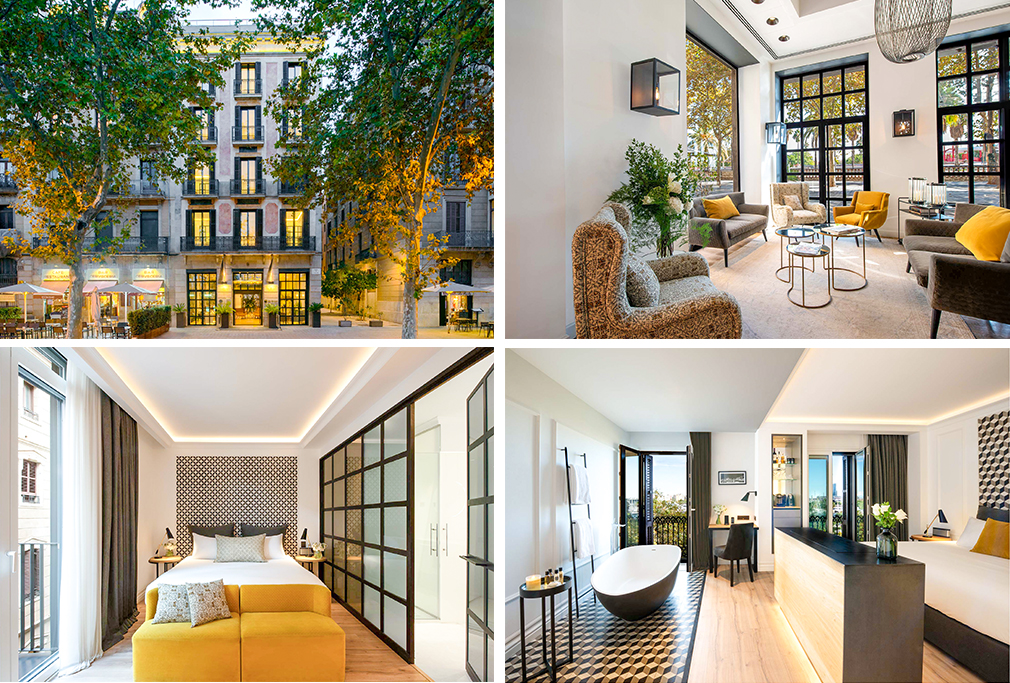
The Historic One: Serras
Inside the same building that once housed Picasso’s first studio, Serras is your quintessential Barcelona hotel hooked in history. Located in the Gothic Quarter and overlooking the superyachts of the Marina Port Vell, this intimate 28-room waterfront lodging exudes laid-back elegance with family-friendly features like roll-away beds, connecting suites, and a rooftop swimming pool. The Catalan-meets-contemporary interiors, designed by Eva Martinez, pay homage to Barcelona’s industrial heritage, oozing black-and-white minimalism against pops of yellow, industrial-height ceilings and windows, and natural accents. There’s a cozy lounge on the mezzanine level, a restaurant serving Catalan cuisine, and a rooftop bar.

The Budget-Friendly One: Praktik Vinoteca
Part of the small Barcelona-based Praktic Hotels chain, Praktik Vinoteca is their wine-themed foray into budget Barcelona stays. Bursting with quirky design features, like vintage vino posters on the walls, mismatched tile floors, and a reception desk that doubles as a walk-up wine bar, a stay at Praktik Vinoteca means a stay in an inspiring space and all-day access to the hotel’s resident sommeliers. Get their recommendations and tasting notes as you sip your way through the stash of Catalan and Spanish wines always available, by glass or by bottle. In the mornings, a breakfast buffet awaits, fully stocked with fresh croissants, cereals, yogurts, cheeses, charcuterie, and Catalonia’s classic pa amb tomàquet (toasted bread with tomato, olive oil, and garlic), along with a Nespresso machine.
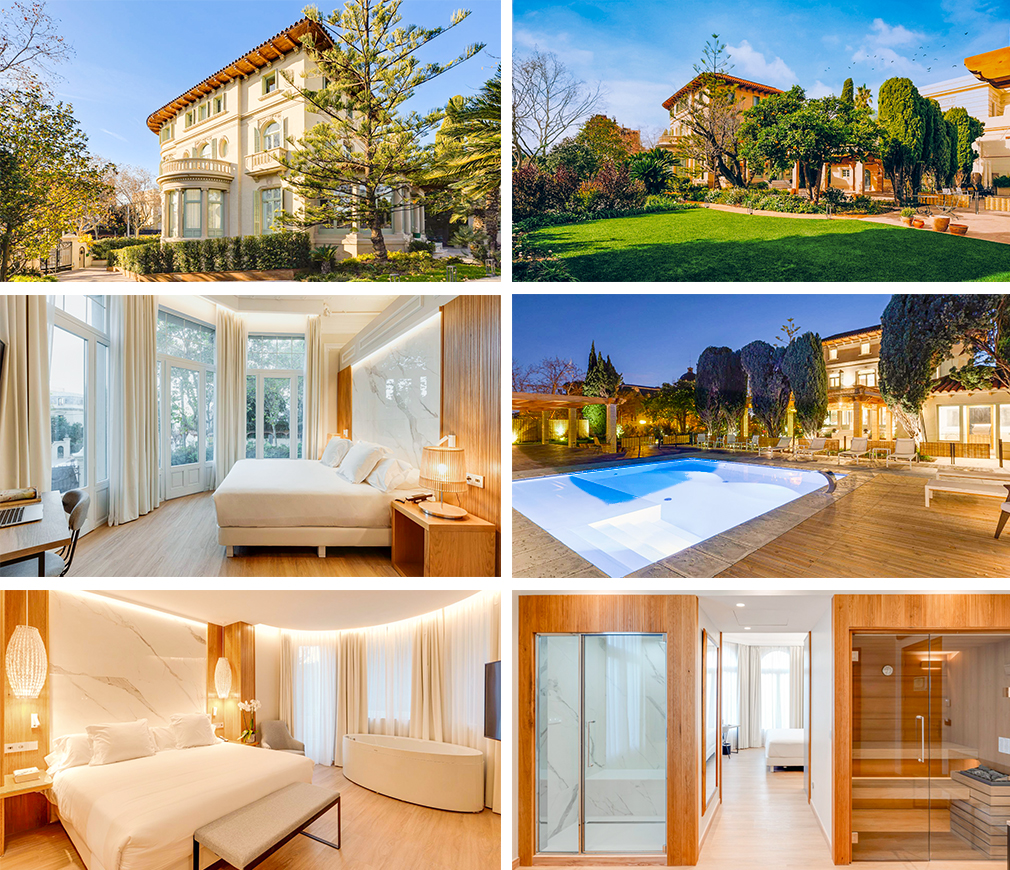
The Wellness One: Hotel Mirlo
Hotel Mirlo is an oasis in the city, nestled in the green folds of Mount Tibidabo and just near the Gaudí-designed Park Güell. Wellness first in every way, each room comes with a private steam room, garden, hydro-massage jacuzzi-style tub, and hammam-style rainfall shower. There’s an outdoor swimming pool surrounded by pristine gardens, grapefruit trees, and palms. The 16-room villa-turned-boutique hotel was built in 1918 as the summer residence of the Macaya family. Today, it’s the ideal spot for those seeking a more tranquil, home-away-from-home experience in the quiet and off-the-beaten-track neighborhood of Sant Gervasi.

The Hip One: Casa Bonay
Embodying the Catalan spirit of community and coming together, Casa Bonay is a carefully curated collection of spaces, stylish details, and hospitality. Their cozy rooms come with yoga kits, Malin+Goetz cosmetics, and MUBI movie-streaming services; some, like the courtyard large terrace rooms, come with outdoor showers, hammocks, and the room’s namesake terrace to soak up the Spanish sunlight. On the ground floor, you’ll find Libertine, the perfect spot to snack on small plates, sip wine, or pop open your laptop, as well as TosTao, a specialty coffee shop serving biodynamic coffee. On the roof, you’ll find two rooftop spaces: one a guest-only exclusive space full of sunbeds, a shower, and even an orchard, the other a lively bar-restaurant called Chiringuito.
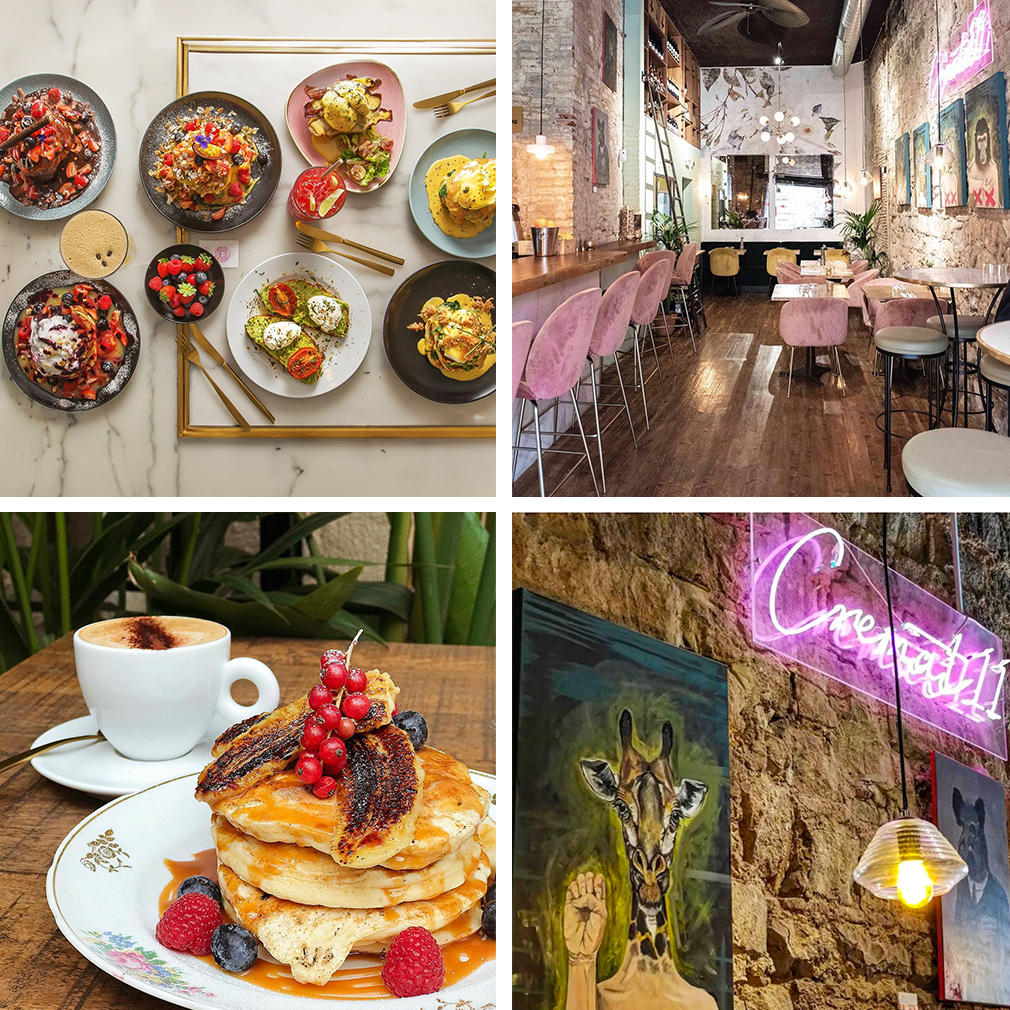
Where to Eat in Barcelona
For Brunch on a Terrace: Cremat 11
Tucked within the El Born neighborhood is Cremat 11, a haven of Instagrammable brunch plates, creative cocktails, quirky interiors, and a quiet and leafy outdoor terrace. It’s a place with personality and the pancakes tell the tale. Served in a fluffy stack of four, dripping with syrup, and topped with fresh fruit and caramelized bananas, these are some of the tastiest and prettiest in town. But if pretty pancakes adorned with passion fruit or bursting with blueberries, bananas, and vanilla aren’t your brunch plate of choice, their eggs Benedict and avocado toast are worthwhile stand-ins.

For Legendary Tapas: La Cova Fumada
A legend among Barcelona’s tapas bars, La Cova Fumada is a three-generation strong hole-in-the-wall restaurant in Barceloneta. Their menu, still written on the chalkboard by the counter, is strictly in Catalan. But no need to translate, just order a few plates of anything with seafood or artichokes when in season, and don’t miss the “bomba,” a deep-fried ball of mashed potato and minced meat served with a heavy-handed drizzle of spicy aioli sauce. La Cova Fumada is where the now Barcelona famous “bomba” originated in 1955.

For a Traditional Fork Breakfast and Menú del Día: La Pubilla
In Barcelona’s Gràcia neighborhood, La Pubilla is a place where knocking elbows with locals over a traditional fork breakfast (esmorzar de forquilla in Catalan) or menú del día is enthusiastically encouraged, though it might require a reservation during the work week. This popular breakfast and lunch spot is more than a century old, and its well-honed, seasonal plates prove it. The concept is authentic Catalan market cuisine sourced straight from the adjacent Mercat de la Llibertat. Be it their hearty Catalan breakfasts or delicious set menu three-course lunches, your palate will be pleased, and your pocket too.

For a Dreamy Dinner: Berbena
While Berbena has only been around since 2019, its basics-done-right concept and subtle hints of Asian and South American flavor on an otherwise Catalan menu have transformed it into a meal you plan ahead for. This reservations-required dinner hour gem in Gràcia is the culmination of chef Carles Pérez de Rozas Canut’s personal travels and work around the world. The dishes, most of which are organic and vegetarian-friendly, are made for sharing and fluctuate with what’s in season, while the beer, coffee, wine, and cheese list is as thoughtfully pulled together as every plate that leaves the kitchen.
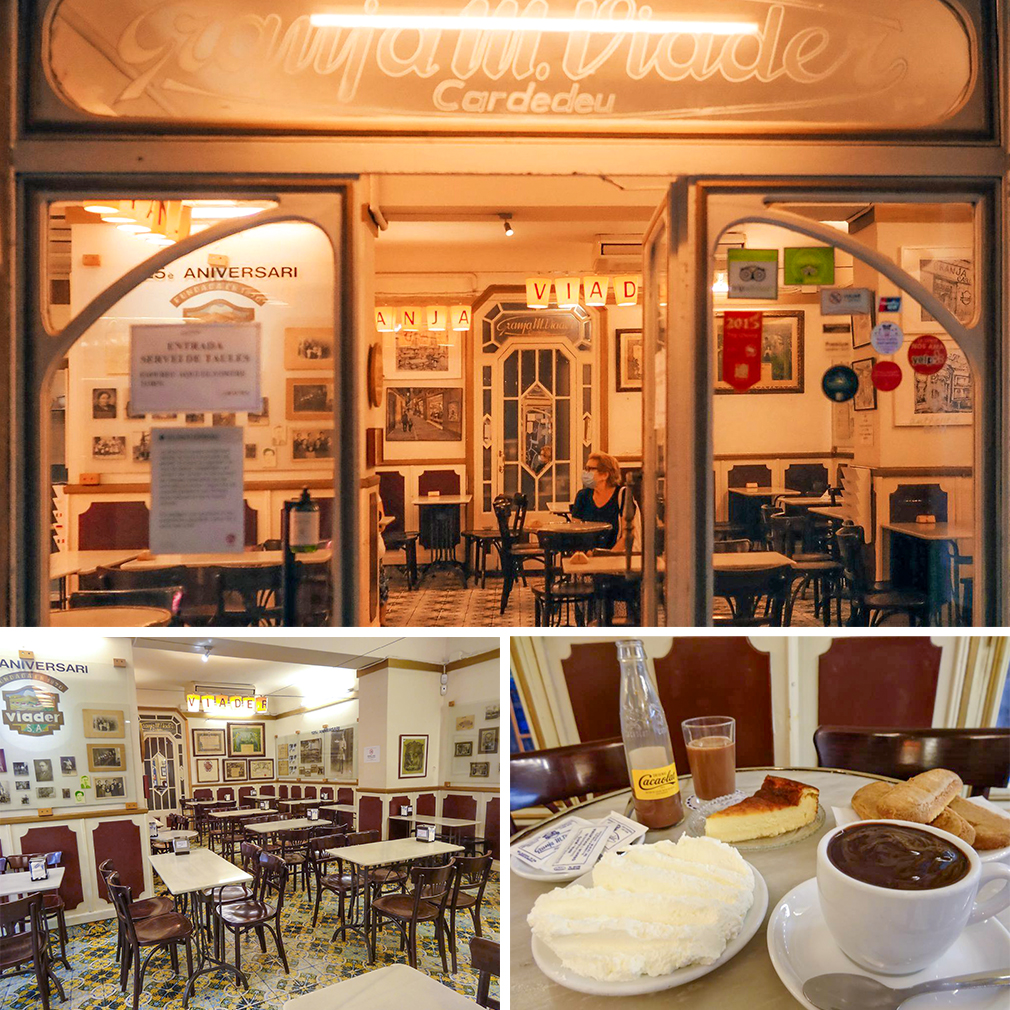
For Churros and Chocolate: Granja M. Viader
In the name of Catalan tradition, make your berenar, a late afternoon snack, something sweet at Granja M. Viader. This historic cafe used to be just a dairy farm, famously credited for inventing the Cacaolat, a bottled chocolate milkshake, in 1931. Five generations later, this family business is one of Raval’s (and Barcelona’s) best spots to order classic churros and chocolate. Granja M. Viader’s version, however, is best enjoyed nata dibuixada-style, which means your dipping chocolate is topped with a dollop of freshly whipped cream.
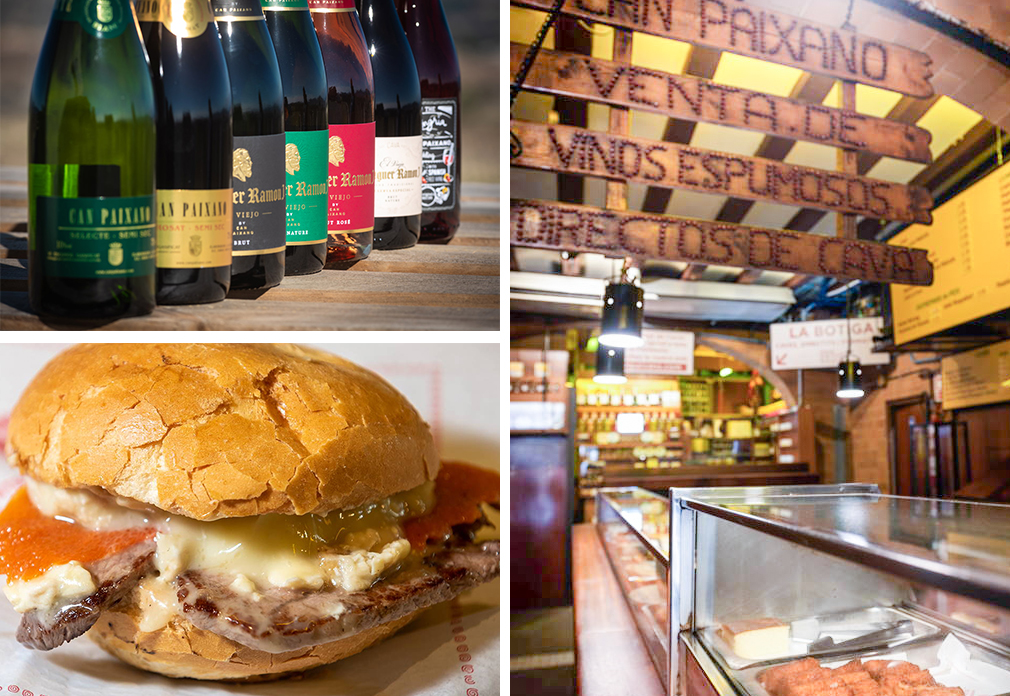
Where to Drink in Barcelona
For Cava: Can Paixano
If you’re lucky enough to snag a table to stand around at this beloved Barceloneta bar, Can Paixano is the spot to toast your trip with a glass of cava or sparkling rosė. Co-owned by three families, all of the cava and sparkling wine on Can Paixano’s menu is produced in collaboration with farmers and manufacturers in the co-ops south of the city. It’s best enjoyed alongside a plate of grilled sausages, manchego cheese, olives, or a fresh-made sandwich oozing with melted cheese.

For Vermouth: Morro Fi
With five locations throughout the city, Morro Fi is irrefutably one of Barcelona’s most sacred spots to sip vermouth, the 20th-century fortified and aromatized wine that’s having somewhat of a resurgence in Catalonia. Morro Fi makes their own artisanal vermouth and preserved tin can goods, like mussels, stuffed squid, razor clams, and anchovies. To enjoy your vermouth at the traditional hour, head to Morro Fi before lunch or start your evening with a glass.

For Coffee: SlowMov
Tucked within the trendy Gràcia neighborhood of Barcelona is SlowMov, a bright, cozy, and foliage-filled coffee shop and roastery serving single-origin, specialty coffee. French-Catalan couple and co-owners François Justet and Carmen Callizo regularly travel to the place of origin of their beans to meet the producers and to source whatever’s in season or has the most interesting flavor profile. With such a meticulous selection process, it’s no wonder they went for a name like SlowMov for their shop. It stands for slow movement because that is exactly how coffee at SlowMov is meant to be enjoyed, slow enough to taste every carefully balanced note as it passes across your tongue.
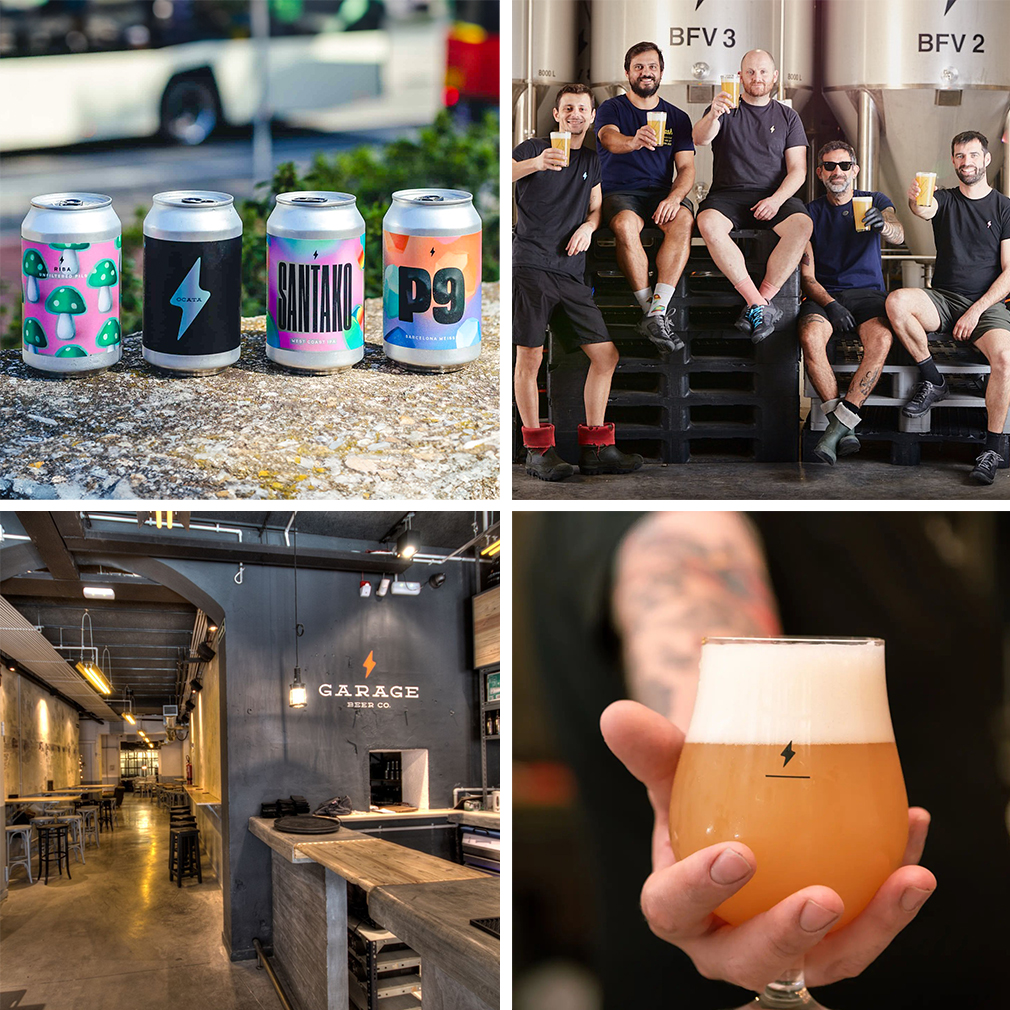
For Craft Beer: Garage Beer Co.
A brewpub at its humble beginnings, Garage Beer Co. has since opened a larger brewery facility to meet the ever-growing demand for its unique and trailblazing beers. Their vintage, industrial-style taproom and brewery in Eixample, with indoor and outdoor seating, always has a wide range of styles on tap, including everything from IPAs to sours, lagers, and a few dark beers. No matter what you order, know it’s Barcelona in a glass: traditional, yet always innovative.
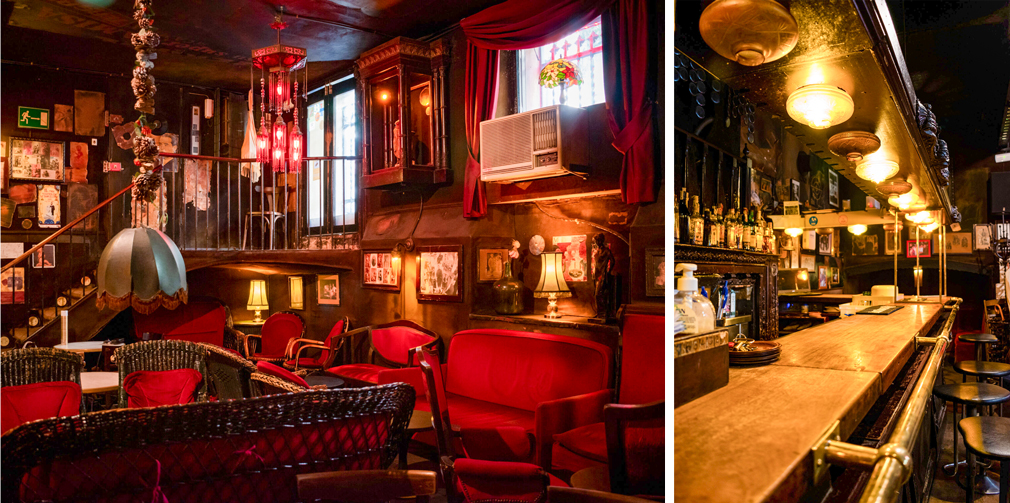
For a Nightcap: Les Gens Que J’aime
Descend into this decades-old basement cocktail bar in Eixample for a nightcap in an eclectic setting. Its red velvet seating, vintage photographs, and tables set up for tarot readings will leave you feeling like you’ve left Barcelona and stepped into another time or realm altogether. Les Gens Que J’aime has been serving old fashioneds and dirty martinis since the late 60s, and the speakeasy-reminiscent ambiance has been luring loyal customers and tourists to it ever since.

Where to Shop in Barcelona
For Locally-Crafted Souvenirs: La Nostra Ciutat
With three locations in the city and each one reminiscent of an outdoor summer market, La Nostra Ciutat is the place to go for souvenirs made by talented local designers, artists, and small businesses. Pop in for a postcard, a print, some fun jewelry, or maybe some home decor if it fits in your suitcase.

For the Gastronomy Goodies: La Boqueria
Arguably Barcelona’s most famous market, La Boqueria has been around since the early 1800s. If shopping for artisanal meats, local cheeses, olives, and other gastronomical delights to gift or stock up on, this is where to find them. You could also pair your shopping experience with a meal at one of the stalls, especially around lunchtime when the market really comes alive.

For Fashion & Couture: Passeig de Grácia
Christened Barcelona’s most luxurious avenue, Passeig de Grácia is a boulevard of modernist and Gaudí-designed buildings housing high-end retailers like Prada, Versace, Stella McCartney, and Louis Vuitton. In the mix, there’s also Santa Eulalia, Barcelona’s oldest design house, whose doors have been open since 1843; LOEWE, a boutique selling beautifully crafted leather goods; and TCN, a Catalan company known for its catwalk-ready clothing, swimsuits, and accessories.

For the Street Market Experience: Palo Market Fest
If you happen to be in Barcelona on the first weekend of the month, don’t miss the Palo Market Fest. This pop-up monthly market takes over the space and environs of an old 19th-century factory in Poblenou. Independent designers, artisans, and food vendors are invited to share their hand-crafted creations with the crowds that unfailingly come for the atmosphere as much as for the innovative cuisine and artisanal goods.

For Something Iconic: La Manual Alpargatera
The espadrille is Catalonia’s contribution to shoes, and there’s nowhere more iconic to purchase a pair than La Manual Alpargatera, the first shop to ever sell them in Barcelona. Part shop, part workshop, and all within a space as large as your living room, La Manual Alpagatera has been making these elegant sandals since 1940. Each and every rope-soled pair is sustainably crafted and entirely handmade right there in the workshop.

Things to Do in Barcelona
Catch the Sunset at the Bunkers del Carmel
Take the 30-minute ascent up to the Bunkers del Carmel, a collection of crumbling anti-aircraft fortifications built to protect the city during the Spanish Civil War in the 1930s. They’re located in the El Carmel neighborhood on the Turó de la Rovira, a hill that’s geographically at the center of Barcelona and therefore grants you 360-degree views of the city, including iconic sights like the Sagrada Familia and Montjuïc. Bring up a few Estrella Galicias or a bottle of cava, some cheese, maybe some cured meats, and make it a picnic as the sun sets the city aglow.

Ride the Cable Car to Montjuïc
Rising above the city skyline in southwest Barcelona is Montjuïc, a wooded hill that once served as the home of Barcelona’s Jewish community. Over the centuries, fortifications have been added, as have gardens, palaces, museums, an Olympic stadium, and leftover installations from the 1929 International Fair. The best way to reach all of it is by the Telefèric de Montjuïc, as much for the aerial views of the city as for the air drop arrival to sites like the Castell de Montjuïc, Joan Miró Foundation, Poble Espanyol, Joan Brossa Gardens, the Mirador de l’Alcalde, and the Olympic Ring. Round-trip tickets cost €16 ($17) and depart from the Parc de Montjuïc.
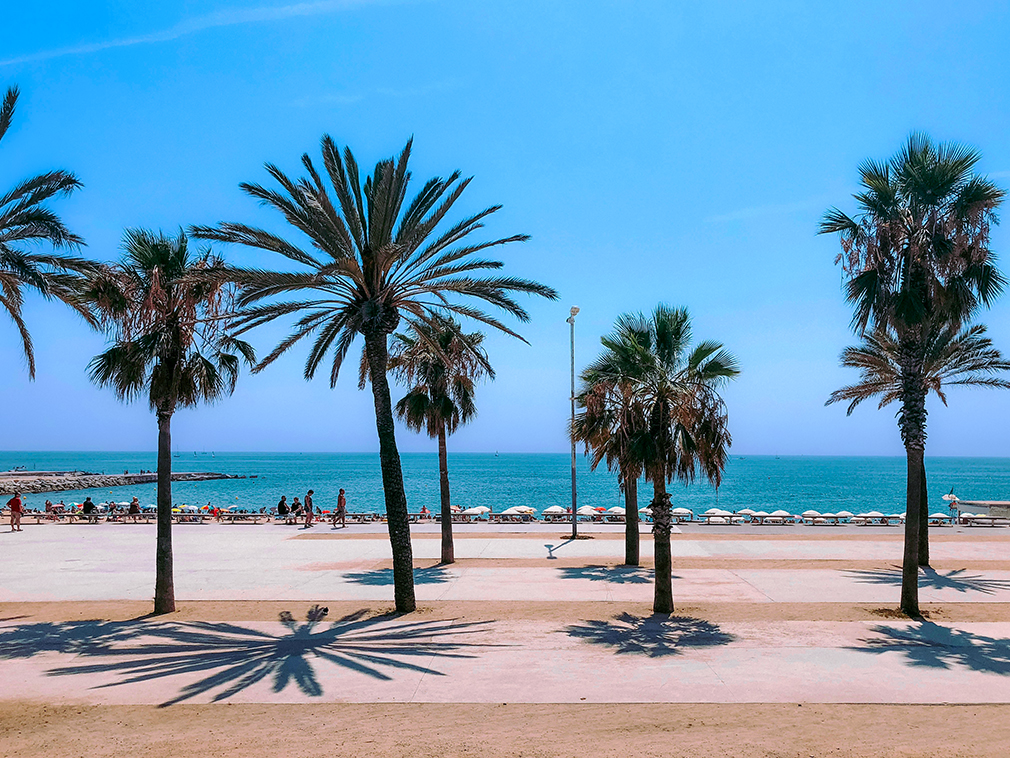
Spend Time on the Sands and Streets of Barceloneta
Every trip to Barcelona should include a visit to Barceloneta, the beachfront district hugging the Mediterranean and still supplying the city’s fresh catch as it has for centuries. Its grid of narrow lanes and a palpable cultural identity, with blue-and-yellow Barceloneta flags waving from the balconies above, is full of charisma and character. Its sand, sea, and promenade are always abuzz with sunbathers, seafood stalls, cyclists, heated games of volleyball, and sometimes sailboats, surfers, and bodyboarders playing with the wind and waves offshore. Spend a morning, an afternoon, an evening, or an entire day immersing yourself in everything “little Barcelona” has to offer.

Go on a Gaudí-themed Pilgrimage Through Town
Plot a path through the city that weaves together Catalan architect and designer Antoní Gaudí’s best contributions to Modernisme art and architecture, a style fathered by Gaudí himself and composed of curved lines and organic forms reminiscent of what’s found in nature. There are at least 12 different Gaudí-designed buildings and structures in Barcelona, starting with the better-known spots like the Sagrada Familia, Park Güell, and Casa Battló, and some lesser-known and less crowded gems like Colonia Güell, the Gaudí-designed mosaic tile floors inside the Church of Sant Pacià, and the pair of six-arm lampposts anchoring the center of Plaça Reial in the Gothic Quarter. The best way to step inside Gaudí’s best work is to purchase the Go Barcelona Pass, a sightseeing ticket that includes guided tours and free entry to seven Gaudí attractions: Sagrada Familia, Park Güell, Casa Milà (La Pedrera), Casa Battló, Casa Vicens, Colonia Güell, and Gaudí Experience 4D.
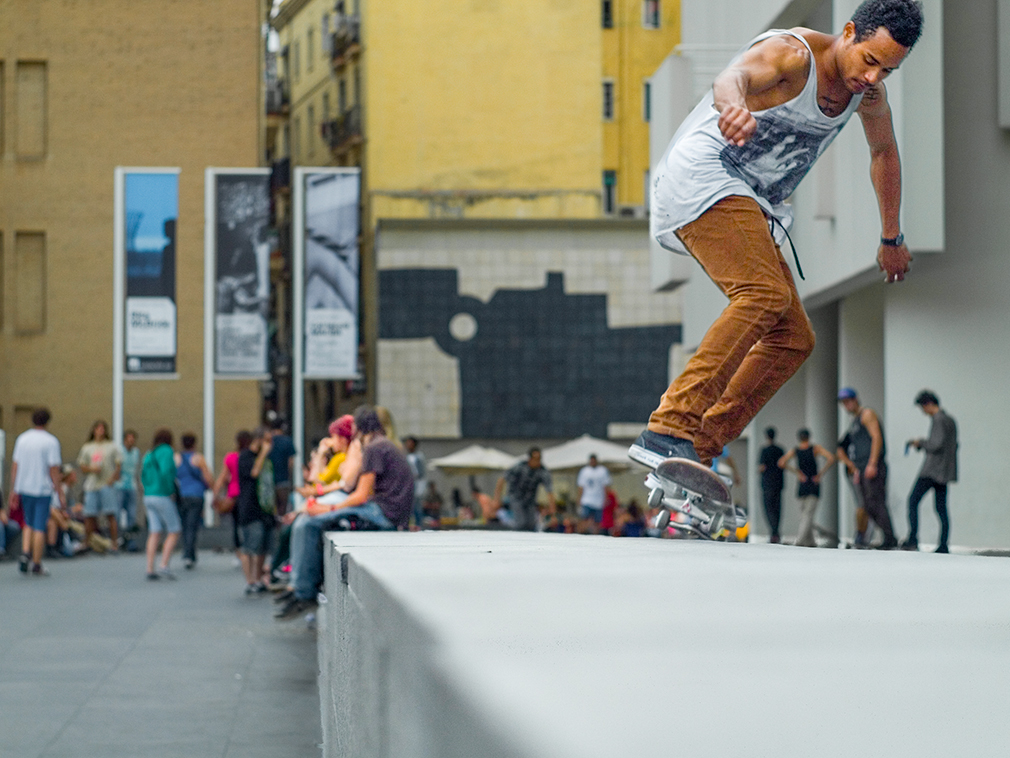
Sample the City’s World-Renowned Skateboarding Culture
Barcelona is known for being one of the world’s skateboarding meccas, a phenomenon that blossomed in the wake of the 1992 Summer Olympics, when the city adjusted its infrastructure to play host, installing wheelchair accessible ramps, more parks, and a suite of new plazas. The plaza in front of MACBA, Barcelona’s contemporary art museum, is the city’s most iconic place to skateboard, as are the ramps and granite benches outside Sants Station. There are skate bars with skateboard bowls inside, like Nevermind Bar in El Raval, and annual skateboard events, like Skate Love Barcelona, that combine music and skating.




